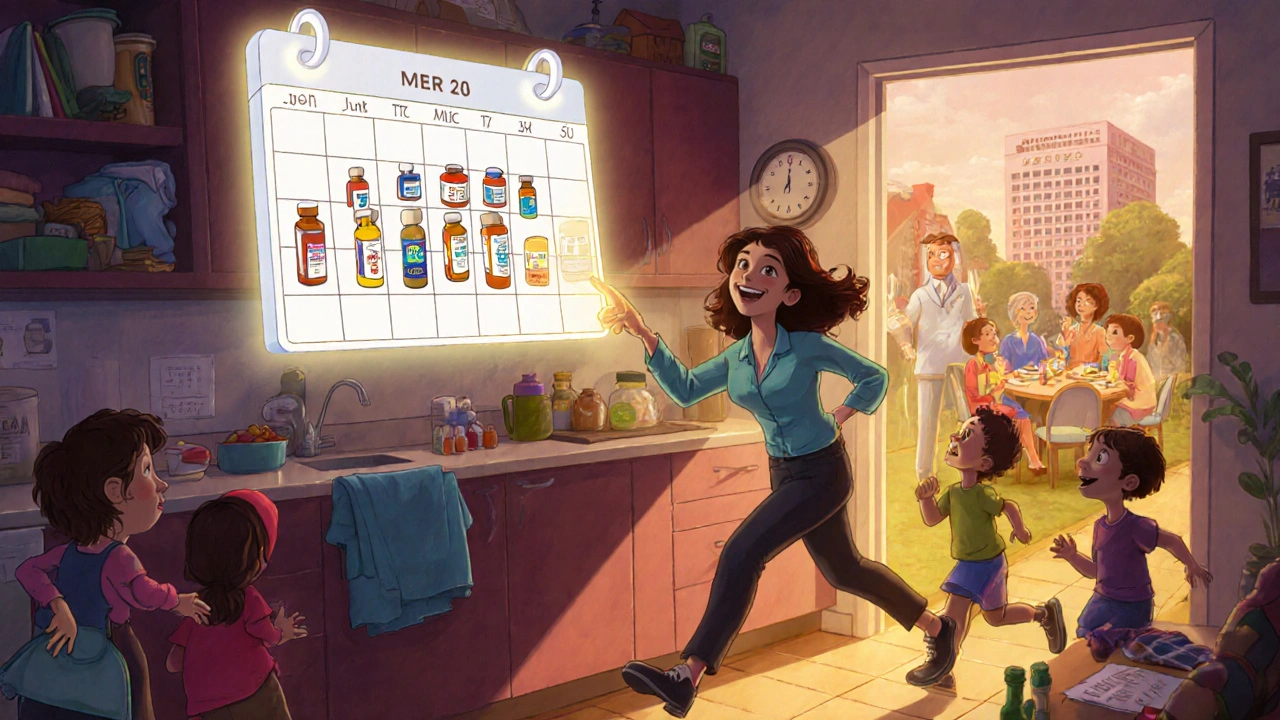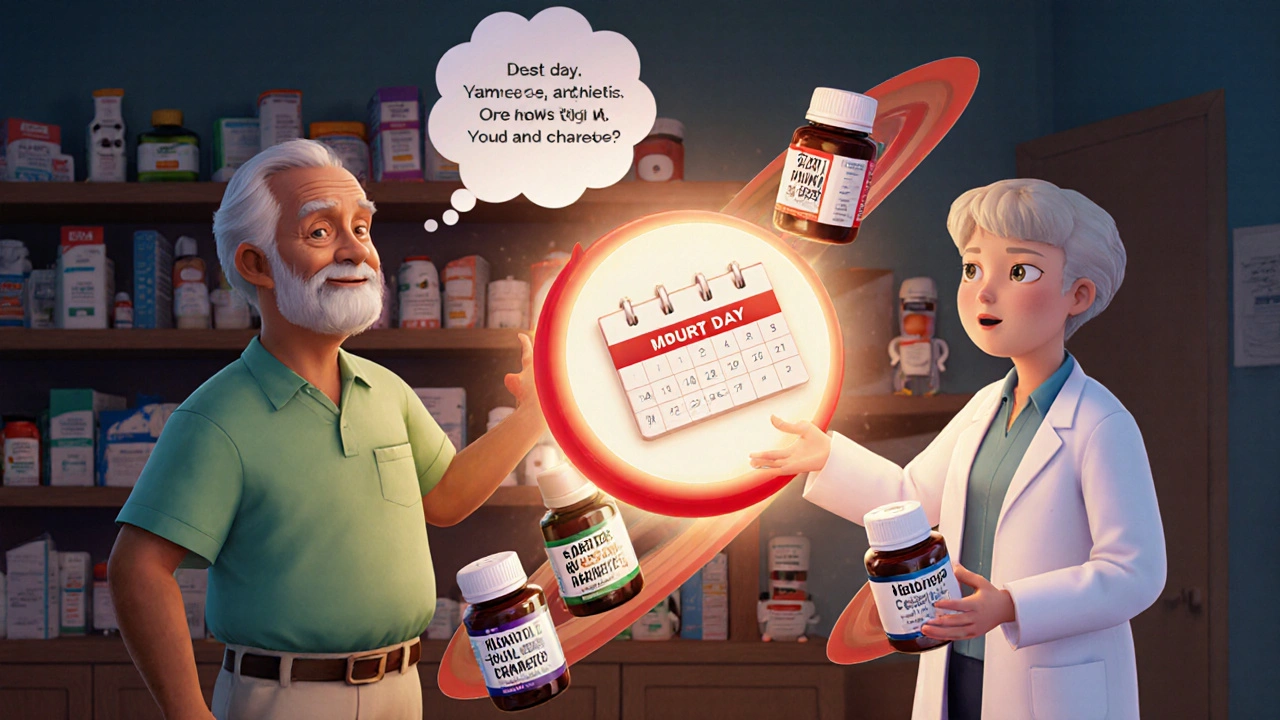Medication Synchronization Calculator
Your Medication Profile
How It Works
Your Results
You Qualify!
Medication synchronization can improve your adherence and prevent gaps in therapy.
With med sync, you'll get all your maintenance medications at once each month.
How Many Visits Will You Save?
You'll make 4 pharmacy visits per year instead of 12 visits.
That's 8 fewer visits annually, saving you time and money.
Your Personal Savings
Estimated time savings: 12 hours per year
Estimated cost savings: $250 per year
Medication adherence rate could improve by 15-25%
Next Steps
Ask your pharmacist about medication synchronization today.
Bring a list of your medications and their current refills.
Pro Tip
Most pharmacies offer med sync for free. Call your pharmacy or ask at your next visit.
Imagine taking five different medications for high blood pressure, diabetes, cholesterol, arthritis, and thyroid issues. Each one has a different refill date. One expires in 10 days, another in 22, another in 30. You forget one. You run out. You skip a dose because you’re too busy to drive to the pharmacy. Then, a week later, you end up in the ER because your blood sugar spiked. This isn’t rare. It happens to millions of people every year.
Medication gaps like this aren’t just inconvenient-they’re dangerous. Studies show that nearly two-thirds of Americans don’t take their prescriptions as directed. And it’s costing the U.S. healthcare system over $300 billion a year in avoidable hospital visits, emergency care, and worsening conditions. The solution isn’t more pills or stricter rules. It’s simpler: synchronize your refills.
What Is Medication Synchronization?
Medication synchronization-often called “med sync”-is a pharmacy service that lines up all your maintenance prescriptions to be refilled on the same day each month. Instead of juggling six different due dates, you pick up everything at once. It’s not a new idea. It started in 1995 in a small community pharmacy in Long Beach, California, when a pharmacist noticed his patients were missing doses because their refills didn’t line up. He started adjusting prescriptions so they all came due together. The results? Fewer missed doses, fewer calls to the pharmacy, and fewer trips to the hospital.
Today, over 78% of independent pharmacies and 65% of chain pharmacies in the U.S. offer med sync. It’s not just a convenience-it’s a proven way to improve adherence. Research shows patients enrolled in med sync programs improve their medication adherence by 15 to 25 percentage points. That’s not a small jump. It’s the difference between staying out of the hospital and ending up in one.
How It Actually Works
It sounds simple, but the process has specific steps. First, your pharmacist identifies which medications qualify. Only maintenance drugs-ones you take daily or weekly for chronic conditions-go into the sync program. That means your daily blood pressure pill, your insulin, your statin. But it doesn’t include things like antibiotics, inhalers you use only when you’re wheezing, or pain pills you take occasionally.
Then, your pharmacist picks an anchor date. This is the day you’ll come in every month to pick up all your meds. It’s not random. You and your pharmacist choose it together. Maybe it’s the first Saturday of the month. Maybe it’s the day after your payday. The goal is to make it fit your life.
Here’s the tricky part: the first time you enroll, you might get fewer pills than usual. If your blood pressure med has 30 days left but your anchor date is in 15 days, your pharmacist will give you just 15 days’ worth. That’s called a short fill. It’s not a mistake. It’s how they get you on the same schedule. After that, you’ll get a full 30- or 90-day supply every month on your anchor date.
Pharmacists also check in with you monthly. They’ll call or text to ask: Are you still taking everything? Any side effects? Did your doctor change anything? This isn’t just a refill reminder-it’s a medication review. And it’s one of the biggest reasons med sync works.
Who Benefits the Most?
Med sync isn’t for everyone. But it’s a game-changer for people with three or more chronic conditions. That includes:
- Elderly patients who struggle to drive to the pharmacy multiple times a month
- People with memory issues or dementia
- Busy parents or professionals who can’t take time off work for multiple pharmacy visits
- Patients on complex regimens-like those with heart failure, diabetes, and kidney disease
- Caregivers managing medications for a loved one
A 2022 survey of 1,200 patients using med sync found that 78% said they took their medications more consistently. Sixty-three percent cut their pharmacy visits from 12 times a year down to just 4. And 87% were satisfied with the service.
One caregiver in Ohio shared how it changed her life: “My mom had five meds. I was constantly checking expiration dates, calling the pharmacy, rushing between appointments. After we synced her refills, I stopped worrying. The pharmacy calls me every month. I just show up. She hasn’t missed a dose in over a year.”

Why It’s Better Than Traditional Refills
Traditional refill systems are broken. They assume you’ll remember six different dates, call six different times, and make six separate trips. But life doesn’t work that way. People forget. They get busy. Insurance rules change. Prescriptions expire before the next refill is due.
Med sync fixes that by turning chaos into routine. Instead of reacting to missed doses, you prevent them before they happen. It also reduces pharmacy errors. When all your meds are reviewed together once a month, your pharmacist catches drug interactions, duplicate prescriptions, or outdated orders faster.
And it’s not just good for patients. Pharmacies benefit too. Staff spend less time answering refill calls. Inventory becomes more predictable. Pharmacists get more time to talk to patients instead of just filling bottles. The American Society of Health-System Pharmacists says med sync creates “structure around the dispensing process”-and that structure saves lives.
Common Problems and How to Solve Them
It’s not perfect. There are hurdles.
Insurance won’t cover early refills. Some Medicare Part D plans don’t allow pharmacies to dispense meds before the original refill date-even if it’s for synchronization. The fix? Your pharmacist can request a one-time exception. Many now have templates ready to send to insurers. If they say no, ask your doctor to write a 90-day prescription with multiple refills. That’s the gold standard.
Your doctor won’t write 90-day scripts. This is a big one. If your doctor only prescribes 30-day supplies, med sync won’t work. You’ll always be one week behind. Talk to your doctor. Say: “I’m enrolling in a medication sync program to help me take my pills better. Can you write 90-day prescriptions with three refills?” Most doctors are willing-if you explain how it helps your health.
You get less medication the first time. That short fill can confuse people. “Why did I get only half my pills?” Don’t panic. It’s temporary. Your pharmacist should explain this clearly before you leave. If they don’t, ask. Write it down. Keep the note in your pill organizer.
It’s not for every drug. Again, only maintenance meds go in. Your rescue inhaler, your antibiotics, your sleep aid-they stay on their own schedule. That’s okay. The goal isn’t to sync everything. It’s to sync what matters most.
How to Get Started
If you’re on three or more chronic medications, ask your pharmacist if they offer med sync. Don’t wait for them to bring it up. Most don’t. You have to initiate it.
Here’s how:
- Make a list of all your medications-name, dose, frequency, refill date.
- Go to your pharmacy and ask: “Do you offer medication synchronization?”
- If yes, ask: “Can we pick a day each month that works for me?”
- If no, ask: “Can you help me get 90-day prescriptions from my doctor?”
- Confirm that your pharmacist will call you monthly to review your meds.
Some pharmacies even let you sign up online or over the phone. Others require an in-person visit. Either way, it’s worth the effort. The time you save-and the health risks you avoid-make it one of the smartest moves you can make for your long-term care.
The Bigger Picture
Med sync is more than a refill trick. It’s part of a larger shift in healthcare-from treating illness to preventing it. The Centers for Medicare & Medicaid Services (CMS) is now considering tying pharmacy quality bonuses directly to how many patients they enroll in med sync. By 2025, pharmacies that sync 40% or more of their chronic medication patients could earn extra payments.
Why? Because the data is clear. When patients take their meds as prescribed, hospitalizations drop. The Congressional Budget Office estimates that if seniors using med sync reduce medication-related hospitalizations by 12%, Medicare could save $4.2 billion a year by 2027.
This isn’t just about pharmacies. It’s about patients taking control. It’s about doctors and pharmacists working together. It’s about building systems that support real life-not punish it.
Final Thought
You don’t need to be perfect to stay healthy. You just need to be consistent. And if you’re juggling multiple prescriptions, consistency is nearly impossible without help.
Medication synchronization isn’t magic. It’s mechanics. It’s planning. It’s a calendar you can trust. And for millions of people, it’s the difference between managing their health-and letting their health manage them.
Can I sync all my prescriptions?
No. Only maintenance medications-those taken daily or regularly for chronic conditions-are eligible. That includes drugs for high blood pressure, diabetes, cholesterol, thyroid issues, and arthritis. PRN (as-needed) medications like pain relievers, inhalers, or antibiotics are not included because they’re not taken on a fixed schedule.
Will I get fewer pills the first time I enroll?
Yes, possibly. If your current prescription has 20 days left but your new sync date is in 10 days, your pharmacist will give you a 10-day supply to align your schedule. This is called a short fill. It’s temporary and done only once. After that, you’ll get full monthly or 90-day supplies on your anchor date.
Does my insurance cover early refills for med sync?
Some do, some don’t. Medicare Part D and some private insurers have rules that restrict early refills. Your pharmacist can request a one-time exception or ask your doctor to write a 90-day prescription with multiple refills, which bypasses the issue. Always confirm coverage before enrolling.
How often will my pharmacist contact me?
Typically once a month, around your refill date. These check-ins are a key part of the program. Your pharmacist will confirm you’re still taking all your meds, ask about side effects, and check for changes in your prescriptions. This is not just a refill reminder-it’s a proactive health review.
What if I miss my sync day?
If you can’t make it on your scheduled day, call your pharmacy. Most will let you pick up early or late without penalty. Some even offer mail delivery or drive-thru options. The goal is to keep you on track, not punish you for a missed date.
Can my doctor refuse to write 90-day prescriptions?
Yes, but they shouldn’t. Many doctors still default to 30-day scripts out of habit. Ask them to switch to 90-day prescriptions with three refills. Explain that you’re enrolling in a medication sync program to improve adherence. Most will agree, especially if you mention the health benefits and lower risk of hospitalization.

